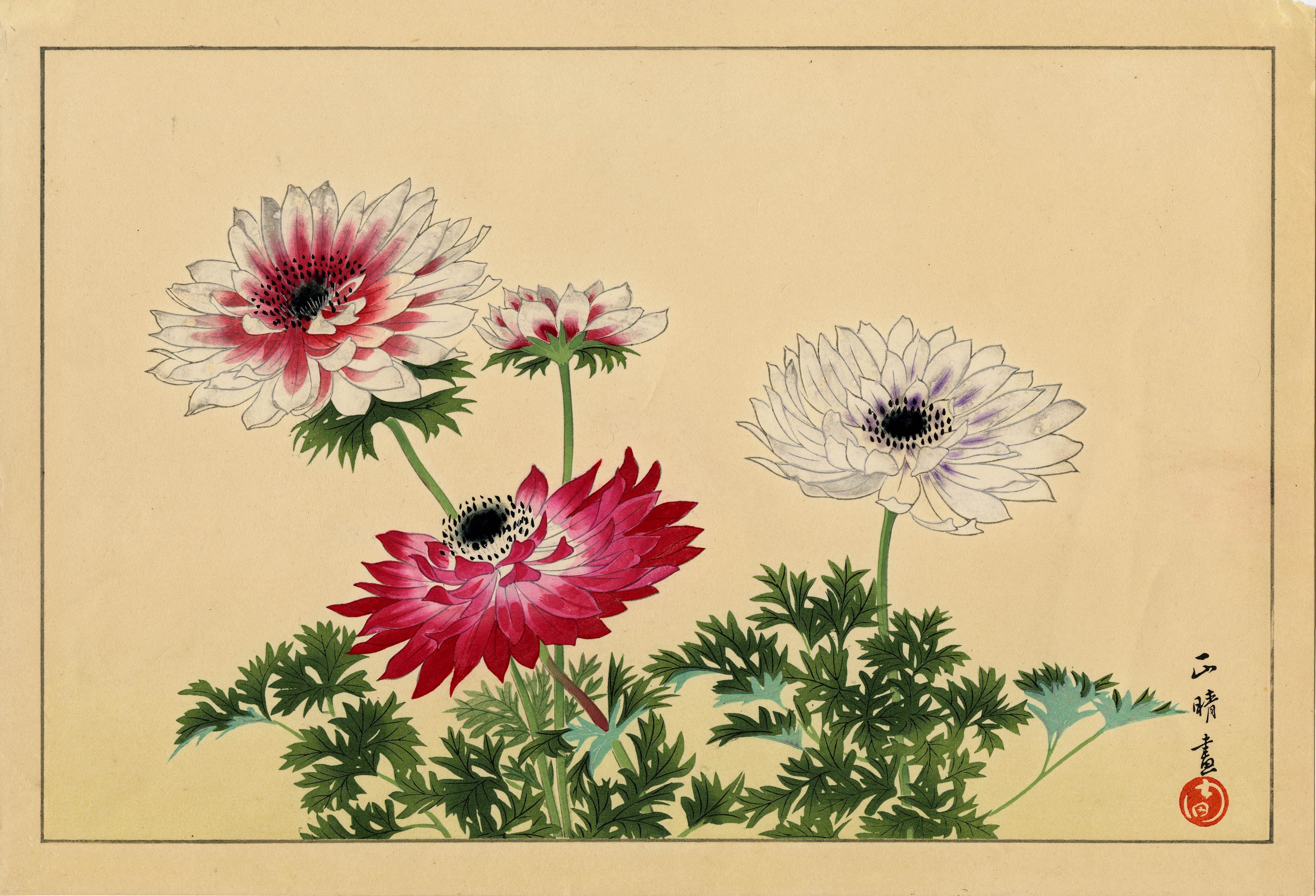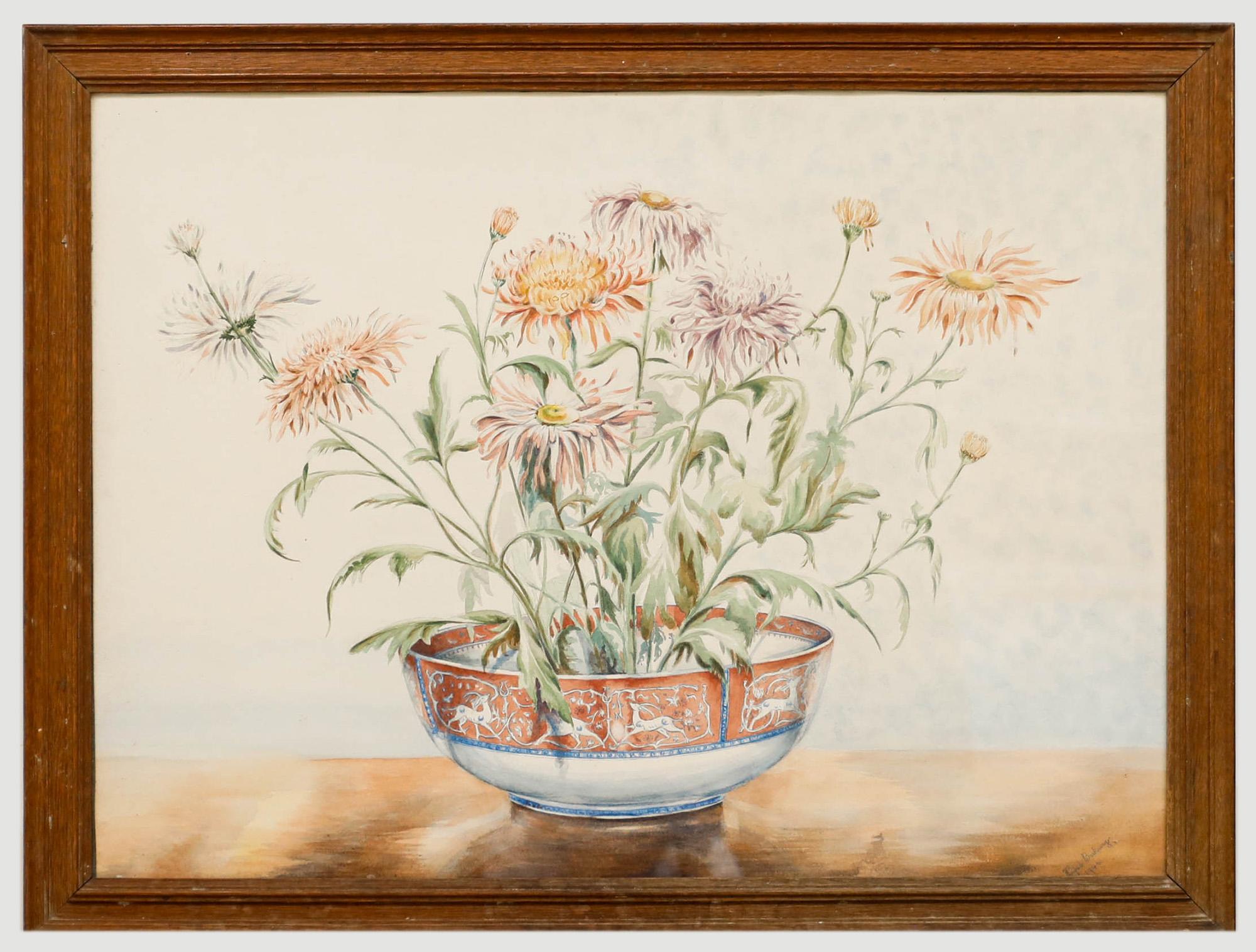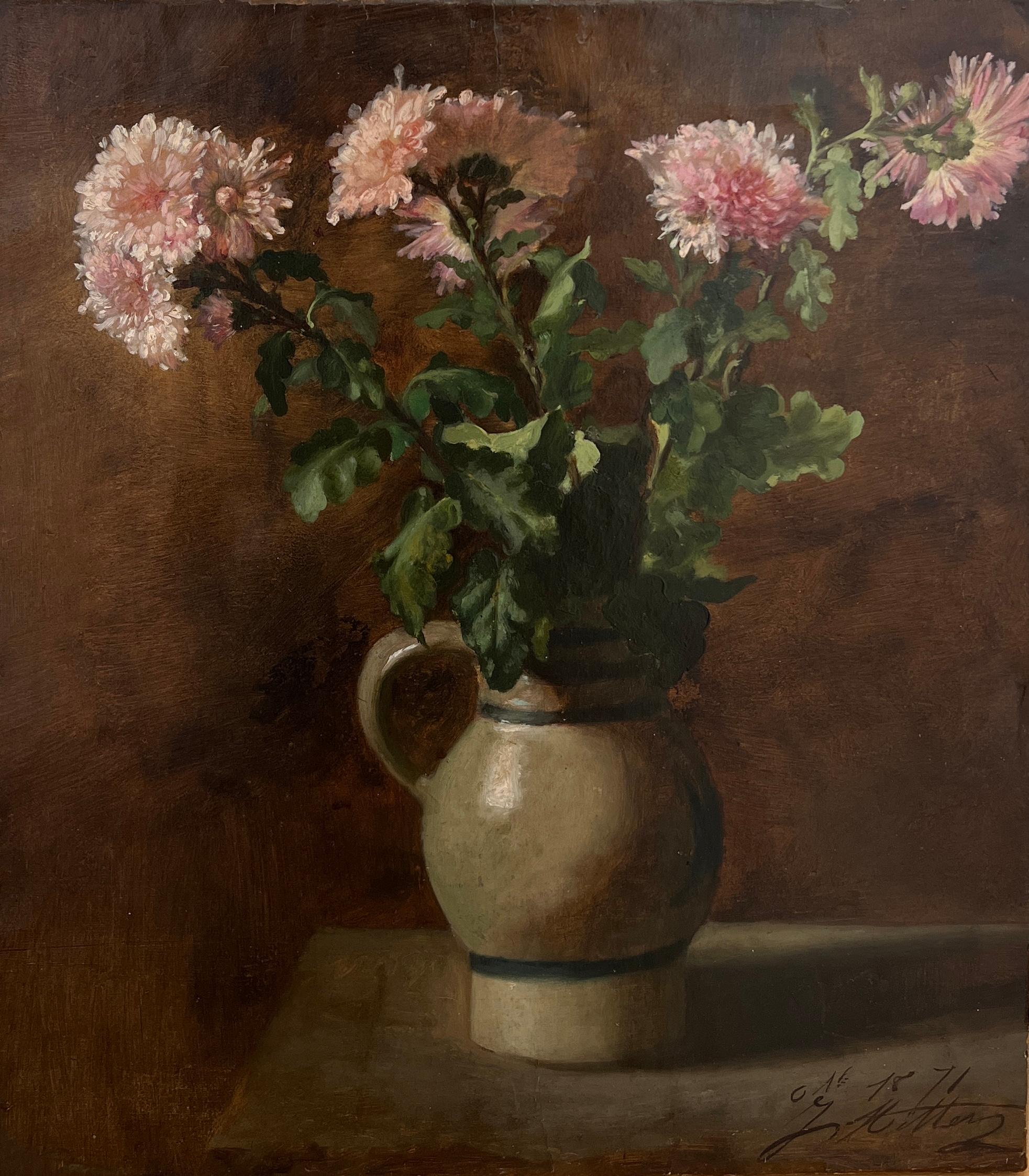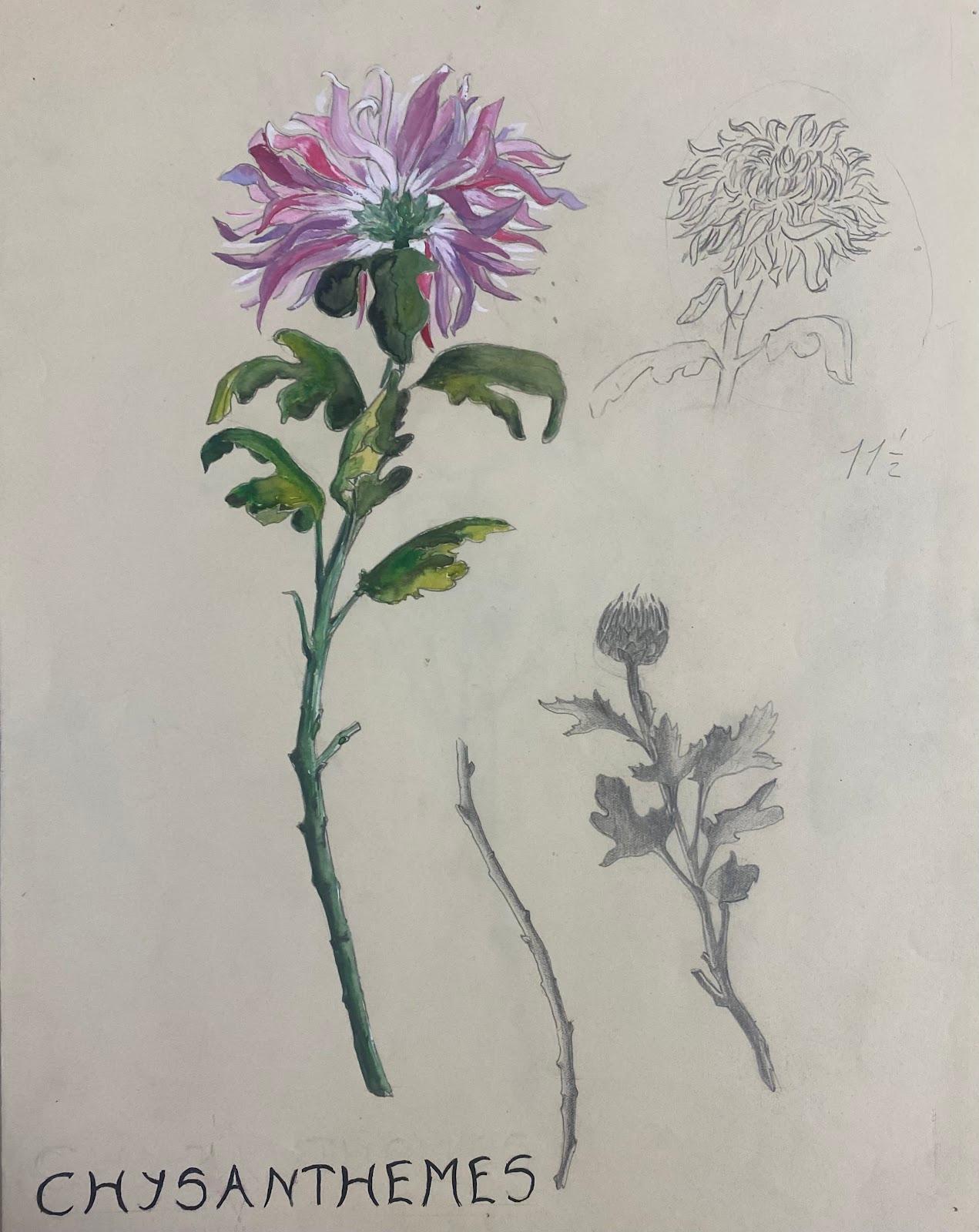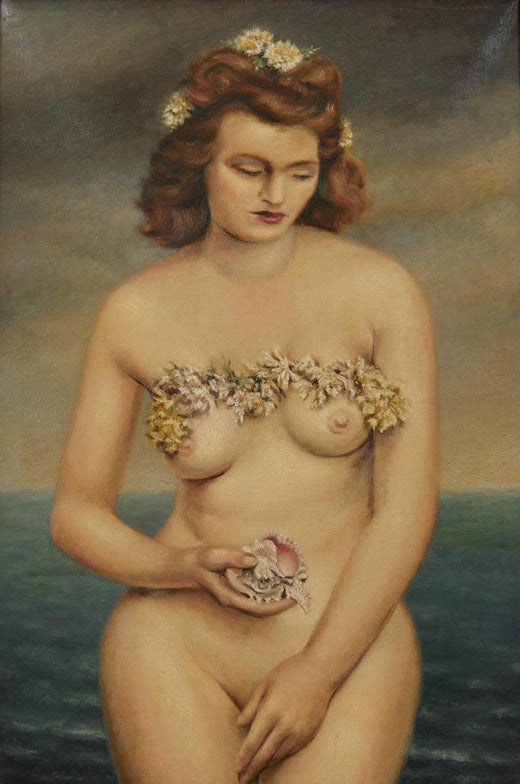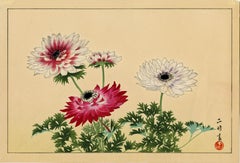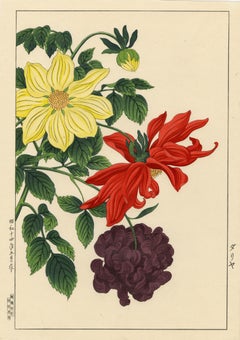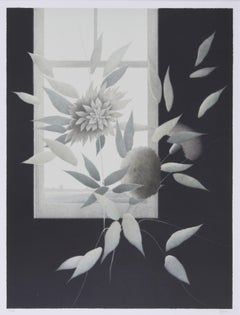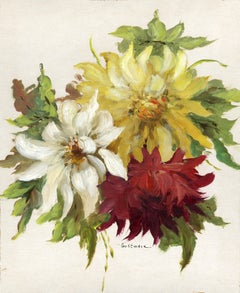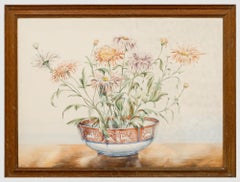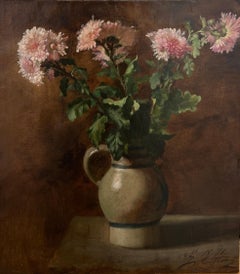Items Similar to Chrysanthemums and Tiger Lilies
Want more images or videos?
Request additional images or videos from the seller
1 of 10
Clarence Holbrook CarterChrysanthemums and Tiger Lilies1935
1935
$8,500
£6,419.85
€7,419.45
CA$11,922.55
A$13,259.03
CHF 6,940.49
MX$161,744.05
NOK 87,209.80
SEK 82,032.07
DKK 55,381.36
About the Item
Chrysanthemums and Tiger Lilies
Signed and dated lower left (twice), see photo
Watercolor on paper, 1935
A symbol of the sun, the Japanese consider the orderly unfolding of the chrysanthemum's petals to represent perfection. Confucius once suggested they be used as an object of meditation. It's said that a single petal of this celebrated flower placed at the bottom of a wine glass will encourage a long and healthy life. Chrysanthemums are the flower for the month of November.
Provenance: Joseph M. Erdelac, Cleveland (noted collector and friend of Carter's)
This work was created during the 1930's when the artist was creating his best works. The 1930's work are the most highly sought after by collectors.
Regarding Carter:
A major watercolorist in the Cleveland, Ohio area in the early 20th century as well as teacher, Clarence Carter was born in Portsmouth, Ohio, and received recognition for his art talent beginning with his childhood.
From 1923 to 1927, he enrolled in the Cleveland School of Art and earned key patronage from William Milliken, Director of The Cleveland Museum of Art and local arts supporter who arranged for Carter to study in Italy with Hans Hofmann in 1927.
Through the next four decades, Carter's works were labeled Surrealism, Magic Realism, Geometric Abstraction, Pop and Op, but no category could capture his style completely.
From 1929 to 1937, Carter taught at the Cleveland Museum of Art, a job arranged by Milliken. From 1937 to 1938, he was Director of the Federal Art Project for Northeastern Ohio, and from 1938 to 1944, he taught at the Carnegie Institute. He also served as guest instructor at various institutions including the Minneapolis School of Art (1949), Lehigh University (1954), Ohio University (1955), Atlanta Art Institute (1957), Lafayette College (1961), and the University of Iowa (1970).
It was in the mid-1960's, in his series called "Mandalas," that his fascination with the egg-shaped ovoid began. Author James A. Michener has commented that the egg in Carter's works is ". . . a mysterious symbol evoking the past, the origins, the overtones of Christianity."
Carter was a member of the American Water Color Society and in 1962, served as Vice President. He used a watercolor technique that involved precise use of form, quick color washes and little retouching. From the beginning of his career, Carter painted in a modernist idiom characterized by a precise, realist line and strong psychological component. His work from the 1930s can be considered part of American Scene painting, and he was much concerned with the complex realities of American rural life.
There is a rich emotional quality to Carter’s work, and he once said “For me no great art has ever existed without some mystery and some awe. That is the vast intangible, which can never be defined but only felt in an elusive way that stirs the spirit.” (Frank Anderson Trapp, Clarence Holbrook Carter [New York: Rizzoli Books, 1989], p. 7)
Courtesy: AskArt
- Creator:Clarence Holbrook Carter (1904-2000, American)
- Creation Year:1935
- Dimensions:Height: 22 in (55.88 cm)Width: 14.75 in (37.47 cm)
- Medium:
- Movement & Style:
- Period:
- Condition:Original condition.
- Gallery Location:Fairlawn, OH
- Reference Number:Seller: FA28501stDibs: LU1408704042
Clarence Holbrook Carter
Clarence Holbrook Carter achieved a level of national artistic success that was nearly unprecedented among Cleveland School artists of his day, with representation by major New York dealers, scores of awards and solo exhibits, and streams of praise flowing from pens of the top art critics. Over the course of his 60+ year career Carter evolved from an exceptionally fine American Scene painter capable of evoking deep reservoirs of mood, into an abstractionist with a strongly surrealist bent. While his two bodies of work seem at first to be worlds apart, owing to their different formal vocabularies, they, in fact, explore virtually the same subject: the nexus between life and death and the transition from earth to spirit. The early work finds its expressive power through specific people, events, and landscapes—most of which are drawn from his experiences growing up in the river town of Portsmouth, Ohio—while the later work from the 1960s on evokes potent states of being through pure flat shape, color and form that read as universals. As his primary form he adopted the ovoid or egg shape, endowing it with varying degrees of transparency. Alone or in multiples, the egg moves through Carter’s landscapes and architectural settings like a sentient spirit on a restless quest. Born and raised in southern Ohio along the banks of the mercurial Ohio River and its treacherous floods, Carter developed a love of drawing as a child, and was encouraged by both his parents. He was self-directed, found inspiration all around him, and was strongly encouraged by the fact that his teenage work consistently captured art prizes in county and state fairs. Carter studied at the Cleveland School of Art from 1923-27, where he trained under painters Henry Keller, Frank Wilcox and Paul Travis. Returning to Cleveland in 1929, Carter had his first solo show, and through Milliken taught studio classes at the Cleveland Museum of Art from 1930-37. In 1938, he moved to Pittsburgh to teach at the Carnegie Institute of Technology until 1944. Carter’s American Scene paintings of the ’30s and ’40s, which launched his artistic star, are the works for which the artist remains best known. During and immediately after World War II, Clarence Carter realized his attraction to bold pattern, dramatic perspective and eye-catching hard-edged design was a poor fit with the prevailing style of Abstract Expressionism. Fortunately, these same hallmarks of his style were prized within the realm of commercial art. Around 1964 Carter acknowledged a need to break from the confines of representational painting. Once Carter had found a potent symbol in the egg, he used it to create an astounding body of imagery for the rest of his life. Among the most ambitious of all his later paintings were his Transections, a theological term meaning to cross, specifically between life and death.
About the Seller
5.0
Recognized Seller
These prestigious sellers are industry leaders and represent the highest echelon for item quality and design.
Gold Seller
Premium sellers maintaining a 4.3+ rating and 24-hour response times
Established in 1978
1stDibs seller since 2013
808 sales on 1stDibs
Typical response time: <1 hour
Associations
International Fine Print Dealers Association
- ShippingRetrieving quote...Shipping from: Fairlawn , OH
- Return Policy
Authenticity Guarantee
In the unlikely event there’s an issue with an item’s authenticity, contact us within 1 year for a full refund. DetailsMoney-Back Guarantee
If your item is not as described, is damaged in transit, or does not arrive, contact us within 7 days for a full refund. Details24-Hour Cancellation
You have a 24-hour grace period in which to reconsider your purchase, with no questions asked.Vetted Professional Sellers
Our world-class sellers must adhere to strict standards for service and quality, maintaining the integrity of our listings.Price-Match Guarantee
If you find that a seller listed the same item for a lower price elsewhere, we’ll match it.Trusted Global Delivery
Our best-in-class carrier network provides specialized shipping options worldwide, including custom delivery.More From This Seller
View AllChrysanthemums
Located in Fairlawn, OH
Chrysanthemums
Color woodcut, c. 1950's
Signed lower right (see photo)
Publisher: Uchida (see photo of red seal)
Note: Chrysanthemums, a symbol of the sun, the Japanese consider the ...
Category
1950s Modern Still-life Prints
Materials
Woodcut
Dahlias
By Nishimura Hodo
Located in Fairlawn, OH
Dahlias
Color woodcut, 1939
Unsigned (as usual)
Format: oban
Publisher: Takemura Hideo
Stamp verso: "Made in Japan"
Provenance: Robert O. Muller
Biography
Hodo Nishimura...
Category
1930s Modern Still-life Prints
Materials
Woodcut
Studio Flowers
By Robert Kipniss
Located in Fairlawn, OH
Studio Flowers
Lithograph, 1982
Signed lower right (see photo)
Numbered lower left
Edition: 120 (42/120) (see photo)
Condition: Mint condition
Two bits of hinge residue verso
Image s...
Category
1980s American Realist Still-life Prints
Materials
Lithograph
untitled (Peonies)
By Frederick Carl Gottwald
Located in Fairlawn, OH
Untitled (Peonies)
Oil on artist's board, c. 1910-1920's
Signed by the artist in ink lower center (see photo)
Provenance:
Joseph Erdelac, Private Collector, Cleveland, acquired from ...
Category
Early 20th Century American Impressionist Still-life Paintings
Materials
Oil
Flower in Vase (Summer)
Located in Fairlawn, OH
Flower in Vase (Summer)
Color woodblock, c. 1950
Signed "B. Ohno" lower right (see photo)
Sealed lower right (see photo)
Series: Flowers of the Four Se...
Category
1950s Other Art Style Still-life Prints
Materials
Woodcut
Hollyhocks
Located in Fairlawn, OH
Hollyhocks
Color woodcut, 1953
Signed with the artist's stamp lower left
Printer: Niimi
Carver: Nagashima
An early printing
Condition: Excellent
Image size: 15 1/2 x 10 3/8 inches
"...
Category
1950s Modern Still-life Prints
Materials
Woodcut
You May Also Like
chrysanthemum
Located in San Francisco, CA
This artwork "chrysanthemum" is an original linocut print on paper by American botanical artist Henry Evans, 1918-1990. It is hand signed, titled, dated and numbered 213/320 in penc...
Category
Late 20th Century American Realist Figurative Prints
Materials
Linocut
Winifred Barkaway (1915-2010) - 1946 Watercolour, Chrysanthemums and Porcelain
Located in Corsham, GB
A delightful depiction of colourful chrysanthemums placed in a shallow porcelain vase. Signed and dated to the lower right. Presented in a wooden frame. On paper.
Category
Mid-20th Century Still-life Drawings and Watercolors
Materials
Watercolor
$268 Sale Price
20% Off
Bouquet of chrysanthemums
Located in Genève, GE
Work on canvas
Category
1870s Still-life Paintings
Materials
Oil
Chrysanthemums 1985. Paper, watercolor, 44x57 cm
Located in Riga, LV
Dzidra Bauma (1930)
Dzidra Bauma works in watercolor technique. She paint figural compositions, portraits, landscapes, flowers and still life. She is one of the most productive wate...
Category
1980s Impressionist Still-life Drawings and Watercolors
Materials
Paper, Watercolor
1950s French Post Impressionist Watercolor Painting Pink Chrysanthemum Flowers
By Josine Vignon
Located in Cirencester, Gloucestershire
Josine Vignon (French 1922-2022)
stamped verso ...
Category
20th Century Still-life Paintings
"Dahlias" Chiura Obata, Japanese American, Red and Blue Delicate Floral Work
By Chiura Obata
Located in New York, NY
Chiura Obata
Dahlias, 1940
Signed, dated and stamped lower right
Watercolor on paper
15 x 9 5/8 inches
Born in the Okayama prefecture of Japan, Chiura Obata was adopted by his uncle, an artist. As a child he was trained in ink painting, and at 14 he was apprenticed to the painter Murata Tanryo in Tokyo. He also studied with Kogyo Terasaki and Goho Hasimoto.
In 1903, Obata moved to San Francisco and began working as an illustrator for The New World and The Japanese American, two of the city's Japanese newspapers. He also did work as a commercial designer. Obata helped establish the East West Art Society in San Francisco in 1921, which sought to promote cross-cultural understanding through art. This goal was reflected in his embrace of the Nihonga style, which fused traditional Japanese sumi-e ink painting with the conventions of western naturalism.
He spent much of the 1920s painting landscapes throughout California, and among his favorite subjects were mountain landscapes. In 1927, he visited Yosemite and the Sierra Nevada, creating over a hundred paintings and sketches of the high country. Obata stayed in the USA until the death of his father in 1928.
Between 1928 and 1932, he worked in Tokyo as a painter and transformed his California landscape watercolors...
Category
1940s Modern Still-life Drawings and Watercolors
Materials
Paper, Watercolor
More Ways To Browse
Vintage Lilies
Tiger Art and Photography
Tiger Paint
Chrysanthemums In Art
Chrysanthemum Japanese
Tiger Drawing
Chrysanthemum Painting
Carter The Great
M Carter
Japanese Tiger
1929 Water Color Painting
Tiger Watercolor Painting
Japanese Painted Eggs
Realism Eggs
Tiger Art Pop Art
James Michener
William Carter
Vintage Japanese Water Flowers
